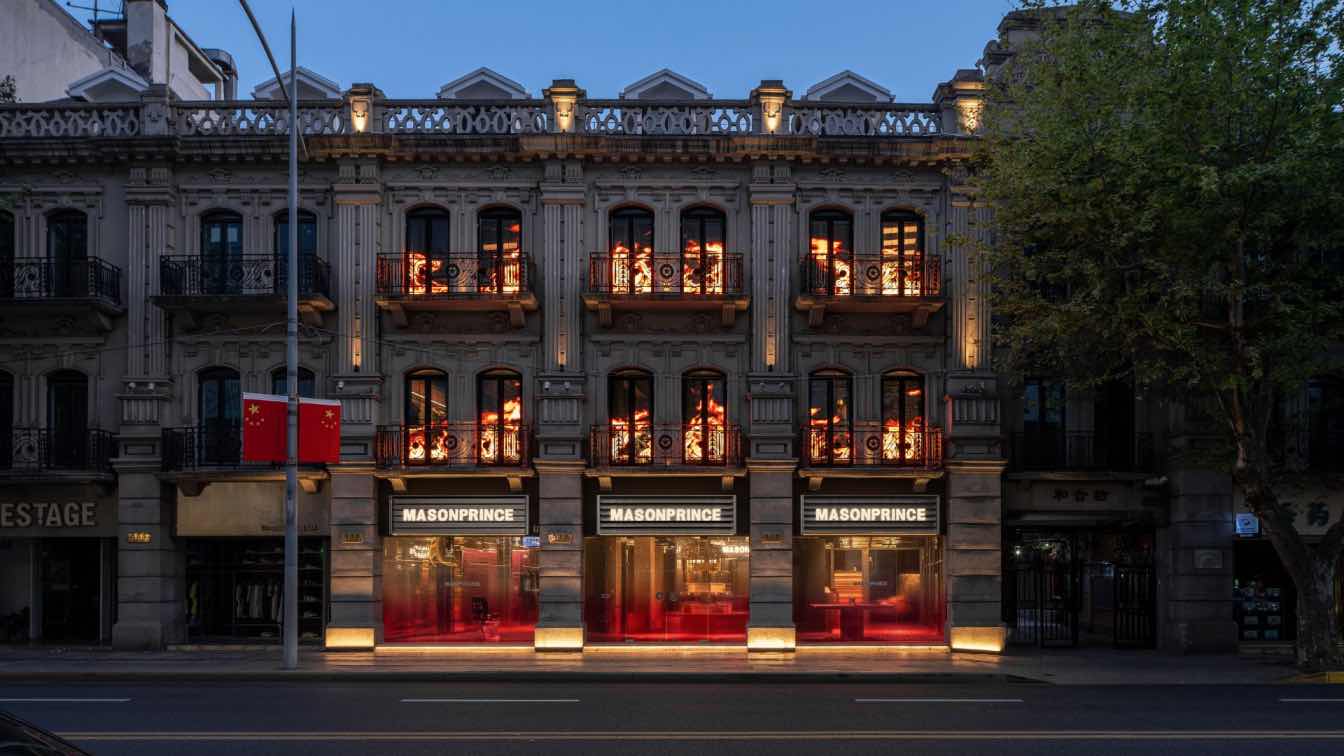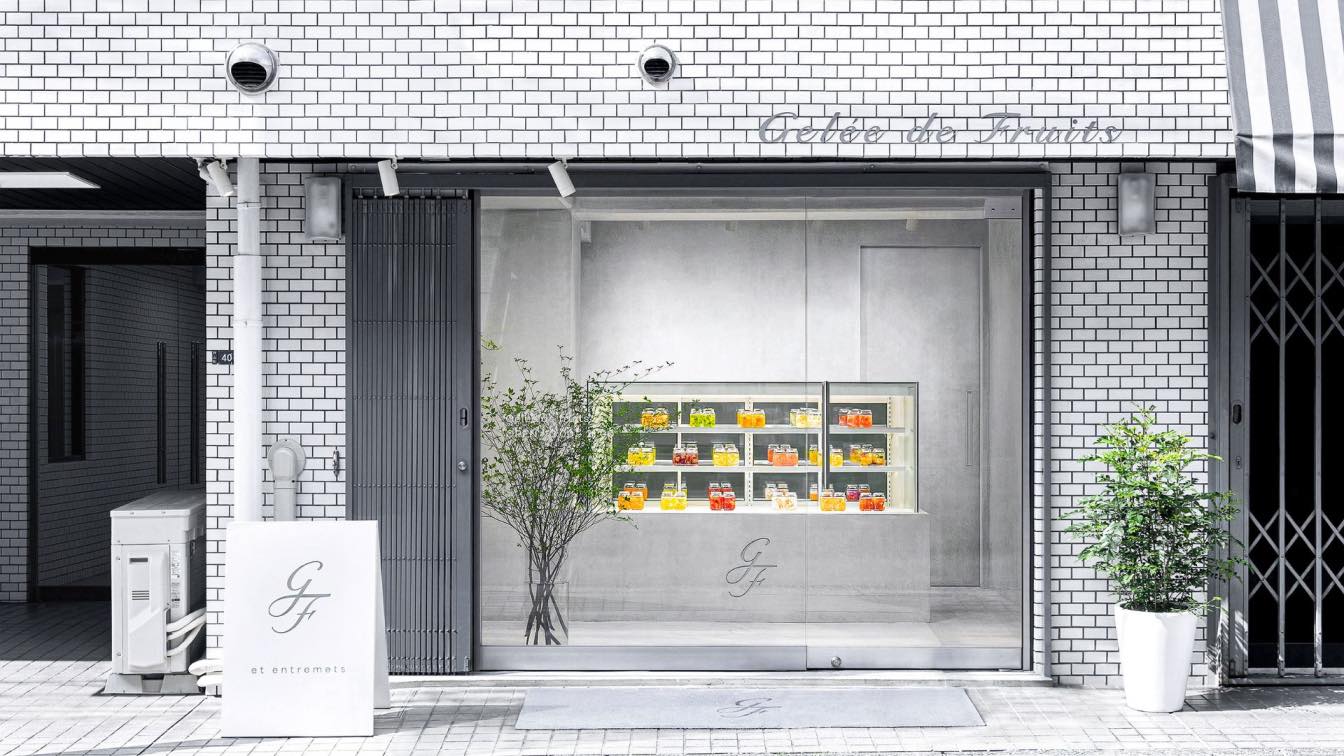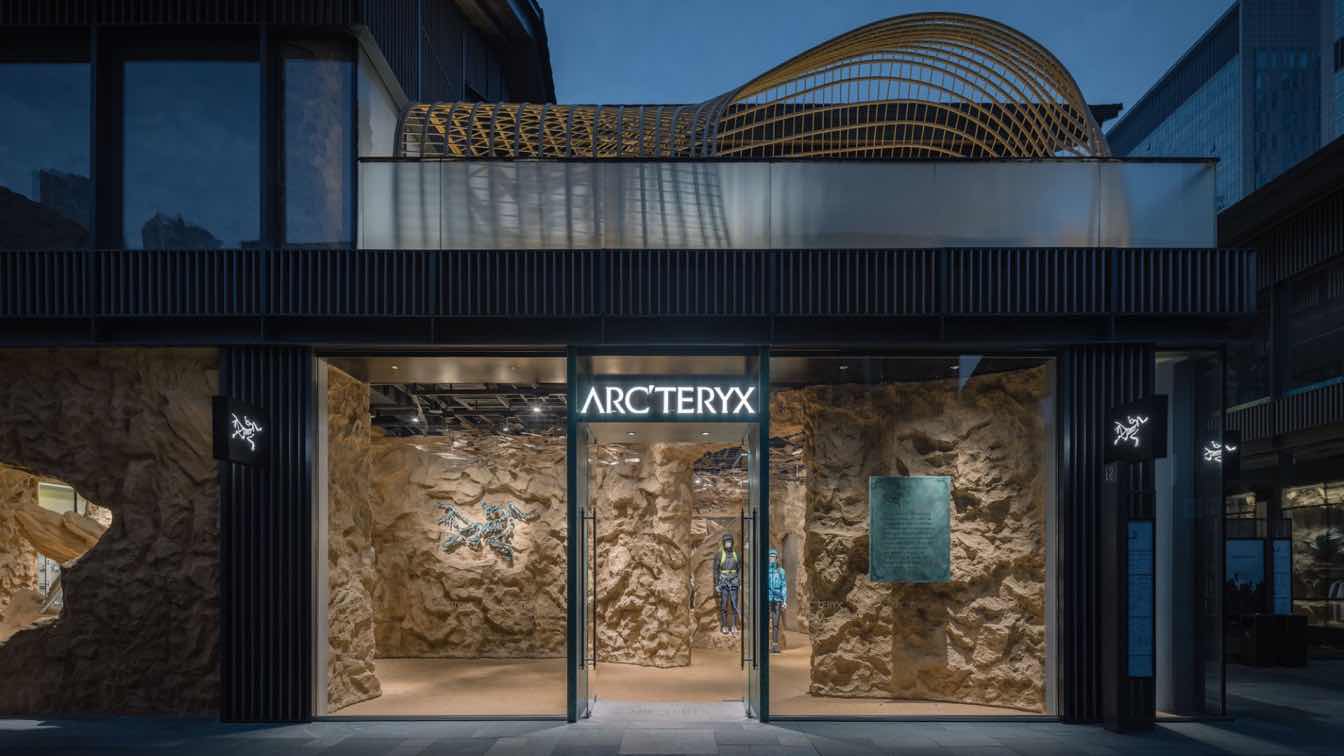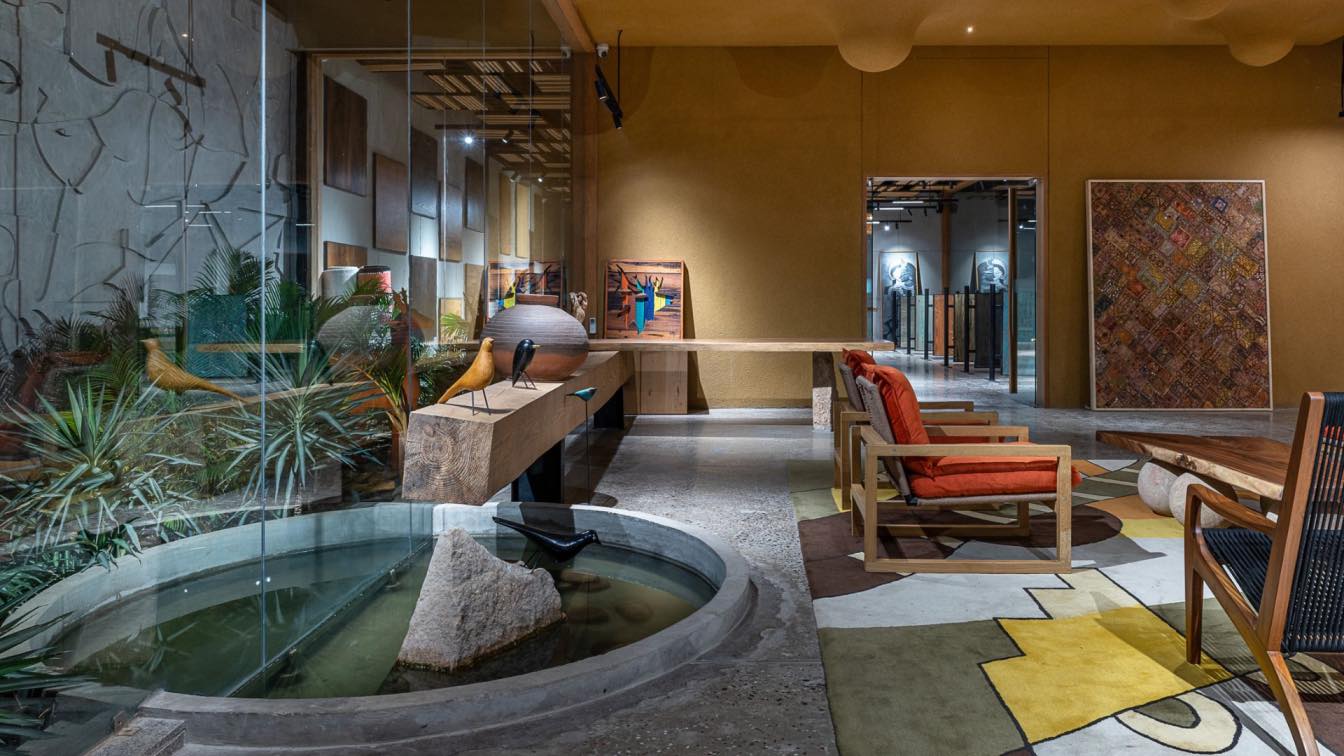At No. 528 Huaihai Middle Road, behind a classical Baroque balcony, a vibrant "blazing flame" highlights MASONPRINCE’s distinctive identity. This surreal “flame”, sparked by MASONPRINCE, has spread from Dongshankou to this location. Crossng the boundary between reality and illusion, a tunnel of consciousness opens up, leading to the "backrooms" of another dimension. In the "backrooms" of the flame, TOMO Design has constructed a new liminal space.
MASONPRINCE (MP), a fashion brand that originated in Shenzhen, has been flourishing for a decade. Known for its “classless fashion” concept and unique retro-futuristic style, MP has become an undefinable trendsetter. Following the success of its first store in Dongshankou, Guangzhou, MP has chosen Huaihai Middle Road, a chic landmark in Shanghai, to establish a new flagship store, once again collaborating with TOMO to envision the space.
This time, TOMO unfolds the "Frontrooms" of everyday life, and presents three-domain "Backrooms" with an illusionary realm that combines surrealism, liminal fantasy, and subconscious exploration.
In the “backrooms”, familiar yet unfamiliar nostalgic scenes blend with a bizarre virtual sense of the future, creating a feeling of frozen time. Visual puzzles and contradictions scattered throughout the space distort memories and sensory perceptions, inviting customers to pause and explore. This unknown environment triggers emotional perception, brings a novel atmosphere to consumers, and enhances the appeal of the clothing displays. All the seemingly bizarre elements serve the spatial narrative. Flames are melting the solid ice of reality. The “backrooms” unfold gradually.

Front Domain – Unknown Route
Conflicts seems to surface at the very beginning of the game. The classical stone Baroque facade exudes a strong sense of history, sharply contrasting with the store signs that shine with silver luster in the form of metallic louvers. The storefront features motorized louver installations and purple-red gradient glass, which disrupt the existing building texture and tone but align with its facade order. Placed between classical columns, they create a conflicting yet dialogic presence.
The design extends the gradient glass elements from MASONPRINCE’s Dongshankou store, where green gradient glass interacts harmoniously with the red-brick building’s street atmosphere. Nestled under thriving parasol trees, the Huaihai Middle Road store, however, chooses a more distinctive purple-red hue. The button-shaped resin door handles are the key to the journey, hinting that fashion is the core theme of this game.
On the purple-red gradient glass, the metallic brand logo becomes the visual focal point. Breaking away from traditional stores that attract passersby with show windows, TOMO opts for gradient glass to create a subtly obscured view, stimulating curiosity and enhancing the narrative.
The enlarged scale of the gradient glass strengthens the entrance’s iconic visual identity, guiding visitors. Behind the glass door is an unknown, surreal world, waiting to be explored.

First Domin: Irrational Lobby
Crossing the boundary of the “frontrooms,” the wonders of the “backrooms” subtly unfold. Dreams are the most direct manifestation of the unconscious and subconscious. They inspire the creation of dream-like “backrooms,” acting as a symbol of the subconscious. Taking this as a source, surrealism emphasizes the omnipotence and irrationality of fantasies. Stepping into the space, visitors are immediately captivated by the visual focal point on the central axis: a surrealist installation that transcends spatial dimensions, connecting upper and lower realms. This, combined with the four split-screen displays of "MP Heterotopia," instantly immerse visitors in a bizarre, dreamlike atmosphere.
The retro-styled PC case and game controller invite interaction with a two-dimensional otherworld. Inside and outside the screens, MP's surreal universe can be explored virtually in two-dimensional time and physically in three-dimensional space. The non-functioning fountain seems to flow endlessly, hinting at a new kind of stability. It invites visitors to dream in this familiar yet strange otherworld and make a wish. At the core of the space lies a visual puzzle: a "dream wishing fountain" constructed from overlapping layers of beige washed stone, merging classical aesthetics with innovative forms. The pool's handrails cleverly transform into “flowing fountains,” with their silver texture resonating with the surrounding mirrored metal elements.
Above the "dream wishing pool," a downwardly swirling “vortex” seems to draw in the lingering dreams of travelers. This transparent vortex, glittering with a crystal-like texture, creates a surreal, dreamlike effect under the interplay of moving people and lights. The main circulation and functional areas are skillfully delineated by different floorings. The main axis features a teak floor with mirrored metal strips, imparting a sense of ceremony. Beige washed stone, embedded with clothing hardware, outlines the boundaries, while blue handmade tiles in the display area evoke a retro feel.

Everday objects, when modified in specific ways, acquire new meanings. On a miniature ping pong table, a roller-skate racket spins on the blue wool felt tabletop, as if searching for a lost ping pong ball. A white toilet unexpectedly turns into a work chair. Unusual materials, unconventional functions, and uncommon combinations create visual puzzles scattered throughout the space. These elements are familiar yet contradictory, crafting a dreamlike scene that appears both realistic and strange. This imbues the objects with a spiritual power, guiding visitors into a surreal dreamscape.
At the end of the first-floor central axis stands the cashier counter, exuding a sense of ritual. Metal grille walls flank the counter, framing it and directing sight lines towards it. Everything operates through contradictions, where derealization undergoes deformation, cultivating ironic absurdity. The counter, along with the symmetrically displayed "file cabinet" and brand logo behind it, is made of silver stainless steel, creating a sense of precise, futuristic distortion. The purple fabric used for the display area walls also wraps the front surfaces of the cashier counter, adding a touch of retro style. The thoughtful material choice cleverly stimulates a dialogue between unconventional textures and a futuristic ambience.
The extensive mirrored grille reflects and fragments the scene, weaving together pieces of dreams. While creating a spatial atmosphere, its structural form is subtly combined with modular rods to meet various wall display needs. The silver aluminum-texture ceiling, coupled with the reflective mirrored grille, creates the illusion of a "floating" ceiling. The customized lamps, with their retro forms, are made of futuristic acrylic, achieving a balance between stability and conflict.
A giant fur boot, disguised as a curious “shopper,” crawls beside the stairs, serving as a guide and observing the diverse dreams in the “backrooms.” The rough walls retain traces of construction, contrasting with the smooth, refined stone stairs and white glass handrails. Speakers embedded onto the glass appear like floating dream whispers. The staircase, constructed of brown stone and ultra-white glass, meanders upward, inviting visitors to step into a deeper "subconscious vortex."

Second Domain: Optical Illusion Bathhouse
The scenes on the second floor seem to be more tangible yet whimsically surreal. Drawing inspiration from medieval saunas and retro bathhouses, this space merges whimsical imagination, distorted memories, optical illusions, and fantastical scene transformations, creating mildly dreamlike absurdity. The central pool, resembling a deep "vortex of the subconscious," swirls quietly, while the diving board in front of it silently beckons to the heart's deepest desires. This surreal environment complements the "dream wishing pool" on the first floor, as if two parallel worlds converge, weaving an illusory dreamscape.
The mirrored ceiling acts as a canvas of magic, stretching the space infinitely and evoking the sensation of stepping into a twisted time-space tunnel. Here, memory and reality intertwine, vision and perception blur, and each scene transition strengthens the dreamlike absurdity, captivating customers. It is a place where reality and dreams merge, facilitating a dialogue between consciousness and the subconscious. The warm "bathhouse" evokes inner peace and tranquility, inviting visitors to recollect lost memories and dreams under the mirrored ceiling.
The space is clad in square salt bricks and beige tile floorings with a lacquer-like texture, while the mirrors and existing columns form a symmetrical visual effect. The walls and floors are fully tiled, complemented by pool, metal beams, showerhead-shaped lights, and wooden stools, all highlighting the “bathhouse” motif. The dim lighting and spacious setting offer a unique aesthetic experience, evoking a surreal mood for new-era consumers.
The silver mirror above the "washing table" flickers with a sci-fi luster, presenting a retro style. The “showerhead” lights and the metallic handles on both sides integrate both functionality and aesthetics. The wall and cabinet integrate display functions, clad in white mosaic tiles with a mottled texture, evoking the essence of an “old bathhouse” setting. In the fitting area, rough natural textures catch the eye and seamlessly integrate into the setting with a harmonious color palette. The delicate artificial green glass door and the natural stone collide, creating a unique and mesmerizing illusion.
Meticulous details define an immersive storytelling ambience. Stone-textured door handles and faucet-shaped hangers evoke old “bathhouse” elements in a contemporary context, bridging reality and memory. Two wild natural stones are connected by industrial metal brackets with an ultra-white glass tabletop. The meticulously arranged lighting projects the exquisite MASONPRINCE logo on the rough stone floor. The space thrives on contradictory contrasts: artificial and natural, rough and delicate, reality and dreams. It transcends ordinary scenes, stimulating a unique exploration enthusiasm in customers.

Third Domain: Heterotopia Studio
Upon ascending the stairs, visitors enter a "studio" that seamlessly blends retro and futuristic elements, crafting a fantastic narrative for the third floor. The “studio” concept, first introduced in MP's initial Dongshankou store, has evolved into this 2.0 version that incorporates more surreal elements. Above the stairs, the "MP founder from the future" — the MP player — holds a gamepad and wears a retro-futuristic VR headset, seemingly controlling the game screen in front of him. This will continually inspire new ideas for the next vision, exploring the MP universe across various periods and locations, guiding customers toward their next adventure.
As the player interacts more with the scene, a surreal “Heterotopia” emerges. A deep walnut-colored corridor, extended by large mirrors, resembles a tunnel of time, inviting consumers to trace back to the classic, timeless quintessence of the past. In contrast, the bright beige "central office area" represents a gateway to the future, opening into an unknown sci-fi world. This interplay not only merges contrasting spatial intentions but also precisely interprets MP’s unique brand identity.
The walnut display cabinet, combined with modular silver metal hardware, meets functional needs while enhancing the retro style, classic yet not old fashioned. Glass and stainless-steel benches, paired with a retro desk with an old computer, blend classic elements with new materials and designs, creating a harmoniously contradictory aesthetic. These pieces are strategically placed along the retro corridor, becoming visual focal points that guide exploration.
The "central office area" turns into a multi-dimensional time stage, with grids of light panels and mirrors interwoven to create an unpredictable visual spectacle. The green carpet and walnut display shelves complement each other, balancing the charm of the past with a futuristic vibe whilst injecting a fluid vitality into the entire space. At the center, a round workstation and four cramped swivel chairs create an "office" scene, as if the MP principals who created this dreamy universe will appear any second, ready to embark on the next bizarre journey.

On the other side of the "office area," the fitting area is conceived as an "elevator hall," where red characters flash on the screens atop the doors, suggesting that pressing the button nearby could transport customers to another dimension. Upon reopening the doors, they might encounter another version of themselves from a parallel universe. The display table in the hall's center, reminiscent of the second-floor "bathhouse," whimsically uses an old copier as its base, continuing the "office" motif.
Incorporating abnormal designs into everyday settings creates bizarre and contrasting scenes, distorting memory and offering an impressive experience. Surreal creations scattered throughout the space construct an "unknown" world, further stimulating exploration and interaction.
In this “heterotopia,” countless familiar elements combine in unprecedented ways: warmth of wood, clarity of glass, solidity of stone, softness of felt, and coolness of metal. These materials creatively interweave, narrating the passage of time from the primitive to the future. Together, they shape a surreal space of retro fashion and whimsical identity, inviting customers to experience endless charm in the interweaving of time and space.
The MASONPRINCE Shanghai Flagship Store on Huaihai Middle Road is an aesthetic statement. Featuring three-domain "backrooms" as liminal spaces, it guides consumers into a surreal otherworld. With unique perspectives, TOMO Design redefines spatial order and perception, infusing the brand's spiritual core into the narrative, and weaving surreal scenes that blend retro and futuristic elements. This store stands as a benchmark for the new generation of experiential retail spaces, drawing continuous visits and fostering brand loyalty among young consumers in Shanghai. It invites consumers to embrace the unknown, contemplate the irrational, and cross visual illusions, ultimately reaching “heterotopia.” A surreal journey across a three-domain space, “backrooms” filled with infinite possibilities, await every explorer’s arrival.


























































